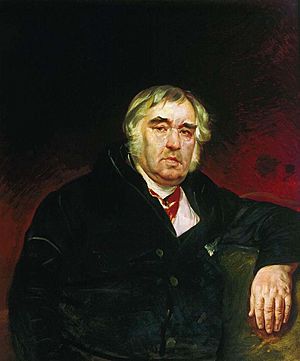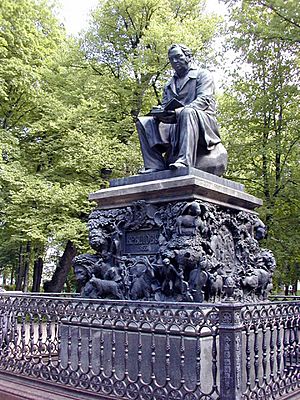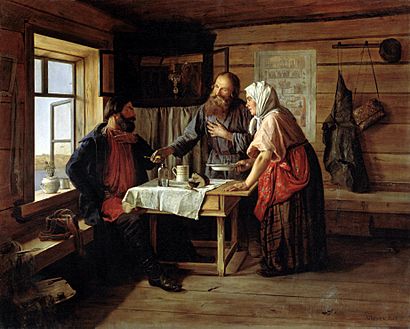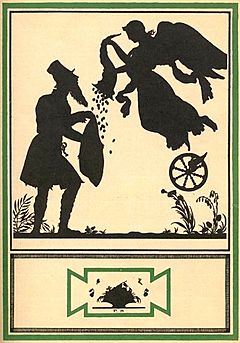Ivan Krylov facts for kids
Quick facts for kids
Ivan Andreyevich Krylov
|
|
|---|---|

Portrait of Krylov by Karl Briullov, 1839
|
|
| Born | February 13, 1769 Moscow |
| Died | November 21, 1844 (aged 75) St. Petersburg, Russian Empire |
| Resting place | Tikhvin Cemetery, Alexander Nevsky Lavra |
| Pen name | Navi Volyrk |
| Occupation | Poet, fabulist, playwright, novelist, journalist, publisher, translator |
| Language | Russian |
| Citizenship | |
| Genre | The fable, play, poetry, prose |
| Years active | 1786-1843 |
| Notable awards | Order of Saint Stanislaus (Imperial House of Romanov), Order of Saint Anna |
Ivan Andreyevich Krylov (Russian: Ива́н Андре́евич Крыло́в; February 13, 1769 – November 21, 1844) was a famous Russian writer. He is best known for his amazing fables, which are short stories that teach a lesson, often using animals as characters. Krylov was also a playwright and journalist. He started writing fables when he was about 40 years old. Many of his early fables were inspired by stories from Aesop and La Fontaine. But later, he wrote his own original fables, often adding a bit of satire, which means he used humor to point out problems in society.
Contents
Who Was Ivan Krylov?
Ivan Krylov was born in Moscow, Russia, in 1769. He spent his younger years in other cities like Orenburg and Tver. His father was a military officer who passed away when Ivan was only ten years old. This left his family without much money.
A few years later, Ivan and his mother moved to St. Petersburg. They hoped to get some financial help from the government. There, Krylov got a job working for the government, but he left it in 1788 after his mother died.
Krylov's Early Writing Career
Krylov started his writing journey in 1783. At just 14, he wrote a comedy play called “The coffee-grounds fortune teller.” He sold it to a publisher, but it was never actually published or performed. With the money he earned, he bought books by famous French writers like Molière. These writers likely inspired his other plays.
Starting in 1789, Krylov tried to create three different literary magazines. None of them became very popular or lasted long. However, his funny comedies and satirical writings helped him become known in literary groups.
For about four years, from 1797 to 1801, Krylov lived on a country estate with Prince Sergey Galitzine. He worked as a secretary and tutor for the prince's children. He left this job in 1803.
Discovering Fables
By 1806, Krylov was in Moscow. He showed two of La Fontaine's Fables that he had translated to another writer, Ivan Dmitriev. Dmitriev encouraged him to write more fables. Soon, Krylov moved back to St. Petersburg. He wrote more plays, like “The Fashion Shop” and “A Lesson For the Daughters.” These plays made fun of how much Russian nobles loved French styles. Krylov disliked this trend his whole life.
Krylov's first collection of fables, with 23 stories, came out in 1809. People loved it so much that he decided to focus only on writing fables. By the end of his life, he had written about 200 fables. He often made changes to them in new editions.
From 1812 to 1841, he worked at the Imperial Public Library. This job was not very demanding, which gave him plenty of time to write. He received many honors for his growing fame. The Russian Academy of Sciences made him a member in 1811. In 1823, they gave him a gold medal. In 1838, a big celebration was held in his honor. Even Emperor Nicholas, who was friends with Krylov, gave him a generous pension.
After 1830, Krylov wrote less. He lived a quiet life. Many stories were told about him, some true and some exaggerated. People talked about his laziness, his love for food, and his clever jokes.
Ivan Krylov passed away in 1844. He was buried next to his friend, Nikolay Gnedich, in the Tikhvin Cemetery.
Krylov's Legacy in Art
Soon after Krylov became famous for his fables, artists started painting his portraits. One of the first was in 1812 by Roman M. Volkov. It showed Krylov leaning on books, holding a quill, looking for inspiration. Other artists like Peter A. Olenin and Johann Lebrecht Eggink painted similar portraits.
In 1832, Grigory Chernetsov painted Krylov with other famous writers like Alexander Pushkin. This painting was set in the Summer Garden.
Statues and Monuments
In 1830, a sculptor named Samuil Galberg made a bust (a sculpture of the head and shoulders) of Krylov. The most famous statue of Krylov was placed in the Summer Garden in St. Petersburg in 1854–55. This was ten years after he died. It was the first monument to a poet in Eastern Europe. The sculptor, Peter Clodt, showed Krylov sitting on a tall base. Around the base are detailed carvings that show scenes from his fables.
Later, other monuments were built that showed scenes from his fables separately. For example, in Tver, where he spent part of his childhood, a monument was put up in 1944. It shows Krylov standing, looking down an alley. Along the alley are metal carvings of his fables. Another monument was placed in Moscow in 1976. This one shows Krylov seated, surrounded by twelve artistic carvings of his fables.
Krylov also shares a monument with the poet Alexander Pushkin in the city of Pushkino. They were friends. Pushkin even used a line from Krylov's fable "The Ass and the Peasant" in his famous novel Eugene Onegin.
Krylov on Stamps and Coins
Some of Krylov's portraits were used on postage stamps. Stamps issued in 1944 for the 100th anniversary of his death used Eggink's portrait. A stamp from 1969, for his 200th birthday, used Briullov's portrait. This same portrait, along with an illustration from his fable "The wolf in the kennel," appeared on a stamp in 1959. In 1994, a silver coin was made to mark 150 years since his death. Many streets in Russia and former Soviet countries are also named after him.
Krylov's Fables: Stories with Lessons
What Makes His Fables Special?
By the time Krylov died, 77,000 copies of his fables had been sold in Russia. His unique blend of wisdom and humor has kept them popular ever since. His fables often connected to real historical events. They are easy to recognize by their simple language and interesting stories.
Krylov started by translating and copying existing fables. But he soon became a very creative writer. He found many new ideas in his own country and in the important issues of his time. Sometimes, this caused problems with government censors. They stopped some of his work from being published. For example, "The Grandee" (1835) was only published after Krylov read it to the Emperor, who found it amusing. Other fables, like "The Speckled Sheep" (1867) and "The Feast" (1869), were not published until long after his death.
Many of Krylov's fables, especially those that made fun of political situations, started from a well-known fable but then changed. For example, his "The Peasant and the Snake" is based on La Fontaine's "The Countryman and the Snake." But in Krylov's version, the peasant kills the snake because it cannot be trusted.
Krylov also used older fables. "The Cat and the Nightingale" is a satire about censorship. A cat catches a nightingale to hear its famous song, but the bird is too scared to sing.
Fables in Other Art Forms
Krylov's fables have been used in many ways, including political caricatures. "The wolf in the kennel" is thought to be about the French invasion of Russia in 1812. The wolf's speech in the fable almost directly quotes Emperor Napoleon.
The fable "The swan, the pike and the crawfish," where they all pull a cart in different directions, originally commented on the fight against Napoleon in 1814. This fable was later used in a satirical drawing in 1854 about the Crimean War. In 1906, it was used again for a caricature about farming policies.
The fables have appeared in many forms, like illustrations on postcards and matchbox covers. The four animals from the popular fable "The Quartet" were even made into porcelain figures in 1949. This was a perfect choice because the fable is about them trying to arrange their seating to perform better.
Not all fables were about animals. "Demyan's Fish Soup" is a funny story about a guest who is given too much food. Artists like Andrei M. Volkov and Andrei Popov painted scenes from this fable.
Illustrated books of the fables have been very popular. In the early 1900s, new art styles were used for them. In 1911, Heorhiy Narbut created beautiful Art Nouveau silhouettes for some of Krylov's fables.
Music Inspired by Fables
Some of Krylov's fables have been turned into music. In 1851, Anton Rubinstein set five of Krylov's fables to music for voice and piano. These included "The quartet" and "The ant and the dragonfly."
Later, Alexander Gretchaninov set four fables for voice and piano. He also created two fables for a choir without instruments. Around this time, Vladimir Rebikov wrote a stage play called Krylov's Fables. His musical settings are said to have inspired Sergei Prokofiev's famous Peter and the Wolf.
In 1913, Cesar Cui set five of Krylov's fables to music. In 1922, a young Dmitri Shostakovich set two fables, "The dragonfly and the ant” and “The ass and the nightingale,” for solo voice and piano. A ballet based on "The dragonfly" was created in 1947 but was not performed.
The Russian La Fontaine
Krylov is often called 'the Russian La Fontaine'. This is because, even though he wasn't the first Russian fable writer, he became the most famous and his reputation has lasted. Both Krylov and La Fontaine wrote their best fables later in life. They thought about their stories carefully and wrote them in the best possible way.
La Fontaine knew Latin, so he could read old versions of Aesop's fables. Krylov learned French as a child and his early work was very similar to La Fontaine's. Even though he didn't know Latin, he taught himself Koine Greek around 1819. This allowed him to read Aesop's fables in their original language.
The main difference between them is that La Fontaine created very few of his own fables. Most of Krylov's work after 1809, however, was either based on just a small idea from other sources or was completely his own invention.
Krylov's first three fables, published in 1806, were very similar to La Fontaine's. Most of the fables in his 1809 collection were also adaptations of La Fontaine. After that, he often took themes from La Fontaine but told the story in his own way. Krylov often added more details than La Fontaine. While La Fontaine was a polite moralist, Krylov was more satirical, using humor to criticize.
Here are some of Krylov's fables that were based on La Fontaine's:
1806
- The Oak and the Reed
- The Choosy Bride
- The Old Man and the Three Young Men
1808
- The Dragonfly and the Ants
- The Raven and the Fox
- The Frog and the Ox
- The Lion at the Hunt
- The Wolf and the Lamb
- The Peasant and Death
- The Fox and the Grapes
- The Fly and the Travellers
- The Hermit and the Bear
1809
- The Cock and the Pearl
- The Lion and the Mosquito
- The Frogs who Begged for a Tsar
- The Man and the Lion
- The Animals Sick of the Plague
- The Two Pigeons
1811
- The Young Crow
- Gout and the spider
- The Banker and the Cobbler
1816
- The Wolf and the Crane
- The Mistress and her Two Maids
1819
- The Shepherd and the Sea
- The Greedy Man and the Hen
1825
- The Lion Grown Old
- The Kettle and the Pot
- The Crow
1834
See also
 In Spanish: Iván Krylov para niños
In Spanish: Iván Krylov para niños









